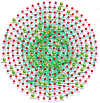A Genome-Wide Association Study and Complex Network Identify Four Core Hub Genes in Bipolar Disorder
- PMID: 29257106
- PMCID: PMC5751362
- DOI: 10.3390/ijms18122763
A Genome-Wide Association Study and Complex Network Identify Four Core Hub Genes in Bipolar Disorder
Abstract
Bipolar disorder is a common and severe mental illness with unsolved pathophysiology. A genome-wide association study (GWAS) has been used to find a number of risk genes, but it is difficult for a GWAS to find genes indirectly associated with a disease. To find core hub genes, we introduce a network analysis after the GWAS was conducted. Six thousand four hundred fifty eight single nucleotide polymorphisms (SNPs) with p < 0.01 were sifted out from Wellcome Trust Case Control Consortium (WTCCC) dataset and mapped to 2045 genes, which are then compared with the protein-protein network. One hundred twelve genes with a degree >17 were chosen as hub genes from which five significant modules and four core hub genes (FBXL13, WDFY2, bFGF, and MTHFD1L) were found. These core hub genes have not been reported to be directly associated with BD but may function by interacting with genes directly related to BD. Our method engenders new thoughts on finding genes indirectly associated with, but important for, complex diseases.
Keywords: GWAS; bipolar disorder; functional enrichment analysis; network analysis.
Conflict of interest statement
The authors declare no conflict of interest.
Figures





Similar articles
-
Epistasis network centrality analysis yields pathway replication across two GWAS cohorts for bipolar disorder.Transl Psychiatry. 2012 Aug 14;2(8):e154. doi: 10.1038/tp.2012.80. Transl Psychiatry. 2012. PMID: 22892719 Free PMC article.
-
Identification of susceptibility modules for coronary artery disease using a genome wide integrated network analysis.Gene. 2013 Dec 1;531(2):347-54. doi: 10.1016/j.gene.2013.08.059. Epub 2013 Aug 29. Gene. 2013. PMID: 23994195
-
Landscape of the relationship between type 2 diabetes and coronary heart disease through an integrated gene network analysis.Gene. 2014 Apr 10;539(1):30-6. doi: 10.1016/j.gene.2014.02.001. Epub 2014 Feb 5. Gene. 2014. PMID: 24508273
-
Transcriptome sequencing implicates dorsal striatum-specific gene network, immune response and energy metabolism pathways in bipolar disorder.Mol Psychiatry. 2017 Mar;22(3):441-449. doi: 10.1038/mp.2016.94. Epub 2016 Jun 28. Mol Psychiatry. 2017. PMID: 27350034
-
Systematic genetic analyses of genome-wide association study data reveal an association between the key nucleosome remodeling and deacetylase complex and bipolar disorder development.Bipolar Disord. 2018 Jun;20(4):370-380. doi: 10.1111/bdi.12580. Epub 2017 Dec 27. Bipolar Disord. 2018. PMID: 29280245
Cited by
-
Involvement of myocyte enhancer factor 2c in the pathogenesis of autism spectrum disorder.Heliyon. 2021 Apr 20;7(4):e06854. doi: 10.1016/j.heliyon.2021.e06854. eCollection 2021 Apr. Heliyon. 2021. PMID: 33981903 Free PMC article. Review.
-
Transcriptome-Wide Identification of G-to-A RNA Editing in Chronic Social Defeat Stress Mouse Models.Front Genet. 2021 May 19;12:680548. doi: 10.3389/fgene.2021.680548. eCollection 2021. Front Genet. 2021. PMID: 34093668 Free PMC article.
-
Emerging roles for MEF2 in brain development and mental disorders.Curr Opin Neurobiol. 2019 Dec;59:49-58. doi: 10.1016/j.conb.2019.04.008. Epub 2019 May 23. Curr Opin Neurobiol. 2019. PMID: 31129473 Free PMC article. Review.
-
Population-based genome-wide association study of cognitive decline in older adults free of dementia: identification of a novel locus for the attention domain.Neurobiol Aging. 2019 Dec;84:239.e15-239.e24. doi: 10.1016/j.neurobiolaging.2019.02.024. Epub 2019 Mar 11. Neurobiol Aging. 2019. PMID: 30954325 Free PMC article.
-
Optical coherence tomography-guided Brillouin microscopy highlights regional tissue stiffness differences during anterior neural tube closure in the Mthfd1l murine mutant.Development. 2024 May 15;151(10):dev202475. doi: 10.1242/dev.202475. Epub 2024 May 17. Development. 2024. PMID: 38682273 Free PMC article.
References
-
- Kessler R.C., Akiskal H.S., Ames M., Birnbaum H., Greenberg P., Hirschfeld R.M., Jin R., Merikangas K.R., Simon G.E., Wang P.S. Prevalence and effects of mood disorders on work performance in a nationally representative sample of U.S. workers. Am. J. Psychiatry. 2006;163:1561–1568. doi: 10.1176/ajp.2006.163.9.1561. - DOI - PMC - PubMed
MeSH terms
Substances
LinkOut - more resources
Full Text Sources
Other Literature Sources
Medical
Miscellaneous

